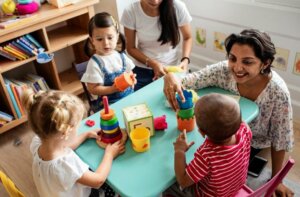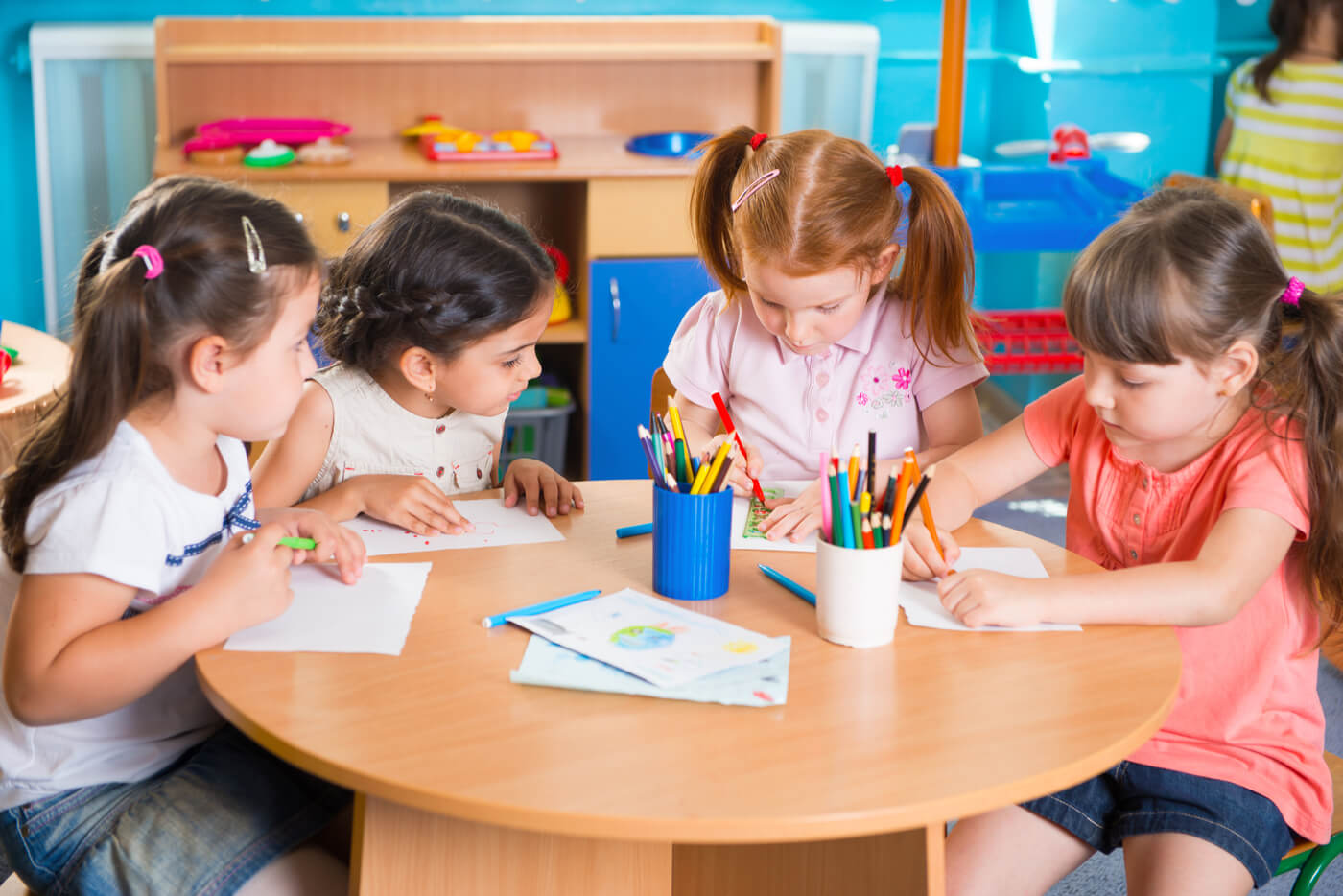Social Constructivism Theory: The Basis for Learning

Throughout history, researchers have postulated various theories to explain how humans acquire new learning. The social constructivism theory is one of the most complete and interesting. And, above all, it’s one of the most applicable in the daily routines of children, both in schools and at home.
Lev Vygotsky, a leading Russian psychologist in the field of child development, was the forerunner of this approach. Drawing on the contributions of Jean Piaget (another prominent figure in the study of childhood), he developed a vision of how a child’s social environment has an enormous impact on their learning.
What is constructivism?
As behavioral psychology become more popular, people began asserting that all behavior is determined by stimuli. Behaviors can be modified depending on the elements that precede it and the consequences that follow it. In fact, may of the current techniques people use to change children’s behavior are based on this idea: reinforcement, token economy, extinction.
However, when it comes to the constructivism theory, this association between stimuli and responses isn’t enough. The theory states that you can’t explain a child’s learning solely in those terms, because learning is an active and subjective task. In addition, learning requires the child’s participation and their own characteristics can influence it.

The importance of schemes
One of the most important precepts of this theory is that learning isn’t based on nothing. The child takes in every new piece of information and analyzes it based on what they already know. With each life experience, the child accumulates knowledge and forms their own schemes. Then, these schemes affect how they see reality.
For example, a child will use their own experience to form their own concept of family. Some may see a family nucleus that includes a father, mother and child. However, there are children who may see a different reality. For example, families with several children, single parents or homosexual parents.
When that happens, the child will approach the new information using the scheme they already have. Then, when they realize the new information doesn’t fit their scheme, they’ll change their scheme to include all the new information.
What does the social constructivism theory add?
Vygotsky takes all these ideas from constructivism, but adds an essential element: socialization. According to him, a child’s social environment heavily influences their cognitive development. That means they learn everything through their interactions with others.
For example, we start talking because our parents talk to us. We start to reason because we see others using reason around us. Therefore, if we didn’t have other people in our environment, these learnings wouldn’t be possible.
There are several documented cases of children who grew up with severe social deprivation. Some studies call them “wild children.” That’s because their learning and development were severely limited due to a lack of socialization.

How to apply the social constructivism theory
If you want to make learning easier for your children, you have to make sure their learning is an active and social process. Reading the information or hearing it from a teacher will never be as effective as allowing your little ones to apply the information and experiment.
In addition, they’ll need to check their own schemes against reality to see where they may be lacking. Then, they can make the necessary changes.
You learn by living, experimenting, observing, and getting involved. Practical use of the information will always lead to more meaningful knowledge than a mere theoretical class.
In addition, it’s important that your little ones are around others when it comes to learning. This is where the concept of the “zone of proximal development” plays a role. This zone defines everything that a child doesn’t know, but could learn with the guidance of someone more competent.
Teachers and parents aren’t the only ones who can play the role of someone who can provide support and guidance. In fact, it’s very beneficial to encourage children to share their knowledge with their peers. That way, they can teach and help others to do their best.
Ultimately, learning is the process of acquiring knowledge. You build on what you already know and continuously learn from those around you. Therefore, the keys to learning are socializing and experimenting.
Throughout history, researchers have postulated various theories to explain how humans acquire new learning. The social constructivism theory is one of the most complete and interesting. And, above all, it’s one of the most applicable in the daily routines of children, both in schools and at home.
Lev Vygotsky, a leading Russian psychologist in the field of child development, was the forerunner of this approach. Drawing on the contributions of Jean Piaget (another prominent figure in the study of childhood), he developed a vision of how a child’s social environment has an enormous impact on their learning.
What is constructivism?
As behavioral psychology become more popular, people began asserting that all behavior is determined by stimuli. Behaviors can be modified depending on the elements that precede it and the consequences that follow it. In fact, may of the current techniques people use to change children’s behavior are based on this idea: reinforcement, token economy, extinction.
However, when it comes to the constructivism theory, this association between stimuli and responses isn’t enough. The theory states that you can’t explain a child’s learning solely in those terms, because learning is an active and subjective task. In addition, learning requires the child’s participation and their own characteristics can influence it.

The importance of schemes
One of the most important precepts of this theory is that learning isn’t based on nothing. The child takes in every new piece of information and analyzes it based on what they already know. With each life experience, the child accumulates knowledge and forms their own schemes. Then, these schemes affect how they see reality.
For example, a child will use their own experience to form their own concept of family. Some may see a family nucleus that includes a father, mother and child. However, there are children who may see a different reality. For example, families with several children, single parents or homosexual parents.
When that happens, the child will approach the new information using the scheme they already have. Then, when they realize the new information doesn’t fit their scheme, they’ll change their scheme to include all the new information.
What does the social constructivism theory add?
Vygotsky takes all these ideas from constructivism, but adds an essential element: socialization. According to him, a child’s social environment heavily influences their cognitive development. That means they learn everything through their interactions with others.
For example, we start talking because our parents talk to us. We start to reason because we see others using reason around us. Therefore, if we didn’t have other people in our environment, these learnings wouldn’t be possible.
There are several documented cases of children who grew up with severe social deprivation. Some studies call them “wild children.” That’s because their learning and development were severely limited due to a lack of socialization.

How to apply the social constructivism theory
If you want to make learning easier for your children, you have to make sure their learning is an active and social process. Reading the information or hearing it from a teacher will never be as effective as allowing your little ones to apply the information and experiment.
In addition, they’ll need to check their own schemes against reality to see where they may be lacking. Then, they can make the necessary changes.
You learn by living, experimenting, observing, and getting involved. Practical use of the information will always lead to more meaningful knowledge than a mere theoretical class.
In addition, it’s important that your little ones are around others when it comes to learning. This is where the concept of the “zone of proximal development” plays a role. This zone defines everything that a child doesn’t know, but could learn with the guidance of someone more competent.
Teachers and parents aren’t the only ones who can play the role of someone who can provide support and guidance. In fact, it’s very beneficial to encourage children to share their knowledge with their peers. That way, they can teach and help others to do their best.
Ultimately, learning is the process of acquiring knowledge. You build on what you already know and continuously learn from those around you. Therefore, the keys to learning are socializing and experimenting.
All cited sources were thoroughly reviewed by our team to ensure their quality, reliability, currency, and validity. The bibliography of this article was considered reliable and of academic or scientific accuracy.
- Payer, M. (2005). Teoría del constructivismo social de Lev Vygotsky en comparación con la teoría Jean Piaget. Caracas, Vanezuela: Universidad Central de Venezuela.
- Ruso, R. C. (2001). El concepto de zona de desarrollo próximo: una interpretación. Revista cubana de Psicología, 18(1), 72-76.
- Mimenza, O. C. Niños salvajes: infancias sin contacto con la humanidad.
This text is provided for informational purposes only and does not replace consultation with a professional. If in doubt, consult your specialist.








